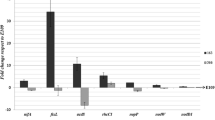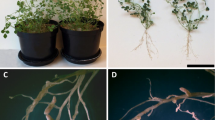Abstract
Nodule formation on alfalfa (Medicago sativa L.) roots was determined at different inoculum dosages for wild-typeRhizobium meliloti strain RCR2011 and for various mutant derivatives with altered nodulation behavior. The number of nodules formed on the whole length of the primary roots was essentially constant regardless of initial inoculum dosage or subsequent bacterial multiplication, indicative of homeostatic regulation of total nodule number. In contrast, the number of nodules formed in just the initially susceptible region of these roots was sigmoidally dependent on the number of wild-type bacteria added, increasing rapidly at dosages above 5·103 bacteria/plant. This behavior indicates the possible existence of a threshold barrier to nodule initiation in the host which the bacteria must overcome. When low dosages of the parent (103 cells/plant) were co-inoculated with 106 cells/plant of mutants lacking functionalnodA, nodC, nodE, nodF ornodH genes, nodule initiation was increased 10- to 30-fold. Analysis of nodule occupancy indicated that these mutants were able to help the parent (wild-type) strain initiate nodules without themselves occupying the nodules. Co-inoculation withR. trifolii orAgrobacterium tumefaciens cured of its Ti plasmid also markedly stimulated nodule initiation by theR. meliloti parent strain. Introduction of a segment of the symbiotic megaplasmid fromR. meliloti intoA. tumefaciens abolished this stimulation.Bradyrhizobium japonicum and a chromosomal Tn5 nod- mutant ofR. meliloti did not significantly stimulate nodule initiation when co-inoculated with wild-typeR. meliloti. These results indicate that certainnod gene mutants and members of theRhizobiaceae may produce extracellular “signals” that supplement the ability of wild-typeR. meliloti cells to induce crucial responses in the host.
Similar content being viewed by others
Abbreviations
- EH:
-
emergent root hairs
- kb:
-
kilobase
- RDU:
-
relative distance unit
- RT:
-
root tip
References
Bauer, W.D. (1981) Infection of legumes by rhizobia. Annu. Rev. Plant Physiol.32, 407–449
Broughton, W.J. (1978) Control of specificity in legume-Rhizobium associations. J. Appl. Bacteriol.45, 165–194
Banfalvi, Z., Sakanyan, V., Konzc, C., Kiss, A., Dusha, I., Kondorosi, A. (1981) Location of nodulation and nitrogen fixation genes on a high molecular weight plasmid ofRhizobium meliloti. Mol. Gen. Genet.184, 318–325
Bhagwat, A.A., Thomas, J. (1982) Legume-Rhizobium interactions: cowpea root exudate elicits faster nodulation response byRhizobium species. Appl. Environ. Microbiol.43, 800–805
Bhuvaneswari, T.V., Bhagwat, A.A., Bauer, W.D. (1981) Transient susceptibility of root cells in four common legumes to nodulation by rhizobia. Plant Physiol.68, 1114–1149
Bhuvaneswari, T.V., Lesniak, A.P., Bauer, W.D. (1988) Efficiency of nodule initiation in cowpea and soybean. Plant Physiol., in press
Bhuvaneswari, T.V., Mills, K.K., Crist, D.K., Evans, W.R., Bauer, W.D. (1983) Effects of culture age on symbiotic infectivity ofRhizobium japonicum. J. Bacteriol.153, 443–451
Bhuvaneswari, T.V., Turgeon, G., Bauer, W.D. (1980) Early stages in the infection of soybean (Glycine max L. Merr.) byRhizobium japonicum. I. Localization of infectible root cells. Plant Physiol.66, 1027–1031
Buikema, W.J., Long, S.R., Brown, S.E., van den Bos, R.C., Earl, C., Ausubel, F.M. (1983) Physical and genetic characterization ofRhizobium meliloti symbiotic mutants. J. Mol. Appl. Gen.2, 249–260
Caetano-Anollés, G., Favelukes, G. (1986) Host-symbiont specificity expressed during early adsorption ofRhizobium meliloti to the root surface of alfalfa. Appl. Environ. Microbiol.52, 377–382
Caetano-Anoll'es, G., Wall, L.G., DeMicheli, A.T., Macchi, E.M., Favelukes, G. (1985) Attachment of nonmotile and nonchemotactic mutants ofRhizobium meliloti to alfalfa roots. In: Nitrogen fixation research progress, p. 257, Evans, H.J., Bottomley, P.J., Newton, W.E., eds. Martinus Nijhoff, Boston
Caetano-Anollés, G., Wall, L.G., DeMicheli, A.T., Macchi, E.M., Bauer, W.D., Favelukes, G. (1988) Role of motility and chemotaxis in efficiency of nodulation byR. meliloti. Plant Physiol., in press
Calvert, H.E., Pence, M.K., Pierce, M., Malik, N.S.A., Bauer, W.D. (1984) Anatomical analysis of the development and distribution ofRhizobium infections in soybean roots. Can. J. Bot.62, 2375–2384
Debelle, F., Rosenberg, C., Vasse, J., Maillet, F., Martinez, E., Denarie, J., Truchet, G. (1986) Assignment of symbiotic developmental phenotypes to common and specific nodulation (nod) genetic loci ofRhizobium meliloti. J. Bacteriol.168, 1075–1086
Debelle, F., Sharma, S.B. (1986) Nucleotide sequence ofRhizobium meliloti RCR2011 genes involved in host specificity of nodulation. Nucleic Acids Res.14, 7453–7472
Djordjevic, S.P., Chen, H., Batley, M., Redmond, J.W., Rolfe, B.G. (1987) Nitrogen fixation ability of exopolysaccharide synthesis mutants ofRhizobium sp. strain NGR234 andRhizobium trifolii is restored by the addition of homologous exopolysaccharides. J. Bacteriol.169, 53–60
Egelhoff, T.T., Fisher, R.F., Jacobs, T.W., Mulligan, J.T., Long, S.R. (1985) Nucleotide sequence ofRhizobium meliloti 1021 nodulation genes:nodD is read divergently fromnod ABC. DNA4, 241–248
Favelukes, G., Caetano-Anollés, G. (1985)Rhizobium meliloti specifically attached to alfalfa roots: obligatory precursor towards nodulation. In: Nitrogen fixation research progress, p. 259, Evans, H.J., Bottomley, P.J., Newton, W.E., eds., Martinus Nijhoff, Boston
Fischer, R.F., Tu, J.K., Long, S.R. (1985) Conserved nodulation genes inRhizobium meliloti andRhizobium trifolii. Appl. Environ. Microbiol.49, 1432–1435
Halverson, L.J., Stacey, G. (1984) Host recognition in theRhizobium-soybean symbiosis. Detection of a protein factor in soybean root exudate which is involved in the nodulation process. Plant Physiol.74, 84–89
Halverson, L.J., Stacey, G. (1985) Host recognition in theRhizobium-soybean symbiosis. Evidence for the involvement of lectin in nodulation. Plant Physiol.77, 621–625
Halverson, L.J., Stacey, G. (1986a) Effect of lectin on nodulation by wild-typeBradyrhizobium japonicum and a nodulation-defective mutant. Appl. Environ. Microbiol.51, 753–760
Halverson, L.J., Stacey, G. (1986b) Signal exchange in plantmicrobe interactions. Microbiol. Rev.50, 193–225
Heron, D.S., Pueppke, S.G. (1987) Regulation of nodulation in the soybean-Rhizobium symbiosis. Strain and cultivar variability. Plant Physiol.84, 1391–1396
Hirsch, A.M., Long, S.R., Bang, M., Haskins, N., Ausubel, F.M. (1982) Structural studies of alfalfa roots infected with nodulation mutants ofRhizobium meliloti. J. Bacteriol.151, 411–419
Hoagland, D.R., Arnon, D.I. (1950) The water-culture method for growing plants without soil. (Calif. Agric. Exp. Sta. Circ. No. 347 (rev. edn.))
Horvath, B., Kondorosi, E., John, M., Schmidt, J., Torok, I., Gyorgypal, Z., Barabas, I., Wieneke, U., Schell, J., Kondorosi, A. (1986) Organization, structure and symbiotic functions ofRhizobium meliloti nodulation genes determining host specificity for alfalfa. Cell46, 335–343
Jacobs, T.W., Egelhoff, T.T., Long, S.R. (1985) Physical and genetic map ofRhizobium meliloti nodulation gene region and nucleotide sequence ofnodC. J. Bacteriol.162, 469–476
Jensen, H.L. (1942) Nitrogen fixation in leguminous plants. I. General characters of root nodule bacteria isolated from species ofMedicago andTrifolium in Australia. Proc. Linn. Soc. N.S.W.66, 98–108
Kondorosi, E., Banfalvi, Z., Kondorosi, A. (1984) Physical and genetic analysis of a symbiotic region ofRhizobium meliloti: identification of nodulation genes. Mol. Gen. Genet.193, 445–452
Long, S.R., Buikema, W.J., Ausubel, F.M. (1982) Cloning ofRhizobium meliloti nodulation genes by direct complementation of Nod- mutants. Nature298, 318–325
Meade, H.M., Long, S.R., Ruvkun, G.B., Brown, S.E., Ausubel, F.M. (1982) Physical and genetic characterization of symbiotic and auxotrophic mutants ofRhizobium meliloti induced by transposon mutagenesis. J. Bacteriol.149, 114–122
Ott, L. (1984) An introduction to statistical methods and data analysis, 2nd edn. Duxbury Press, Boston, Mass., USA
Pierce, M., Bauer, W.D. (1983) A rapid regulatory response governing nodulation in soybean. Plant Physiol.73, 286–290
Putnoky, P., Kondorosi, A. (1986) Two gene clusters ofRhizobium meliloti code for essential nodulation functions and a third influences nodulation efficiency. J. Bacteriol.167, 881–887
Renalier, M.H., Batut, J., Ghai, J., Terzaghi, B., Gherardi, M., David, M., Garnerone, A.M., Vasse, J., Truchet, G., Huguet, T., Boistard, P. (1987) A new symbiotic cluster on the pSym megaplasmid ofRhizobium meliloti 2011 carries a functionalfix gene repeat and anod locus. J. Bacteriol.169, 2231–2238
Rodriguez-Quinones, F., Banfalvi, Z., Murphy, P., Kondorosi, A. (1987) Interspecies homolog of nodulation genes inRhizobium. Plant Mol. Biol.8, 61–75
Rolfe, B.G., Gresshoff, P.M., Shine, J., Vincent, J.M. (1980) Interaction between a non-nodulating and an ineffective mutant ofRhizobium trifolii resulting in effective (nitrogenfixing) nodulation. Appl. Environ. Microbiol.39, 449–452
Rosenberg, C., Boistard, P., Dénarié, J., Casse-Delbart, F. (1981) Genes controlling early and late functions in symbiosis are located on a megaplasmid inRhizobium meliloti. Mol. Gen. Genet.184, 326–333
Sargent, L., Huang, S.Z., Rolfe, B.G., Djordjevic, M.A. (1987) Split-root assays usingTrifolium subterraneum show thatRhizobium infection induces a systemic response that can inhibit nodulation of another invasiveRhizobium strain. Appl. Environ. Microbiol.53, 1611–1619
Takats, S.T. (1986) Suppression of nodulation in soybeans by superoptimal inoculation withBradyrhizobium japonicum. Physiol. Plant.66, 669–673
Truchet, G., Debellé, F., Vasse, J., Terzaghi, B., Garnerone, A.M., Rosenberg, C., Batut, J., Maillet, F., Dénarié, J. (1985) Identification of aRhizobium meliloti pSym 2011 region controlling the host specificity of root hair curling and nodulation. J. Bacteriol.164, 1200–1210
Truchet, G., Rosenberg, C., Vasse, J., Julliot, J.S., Camut, S., Dénarié, J. (1984) Transfer ofRhizobium meliloti pSym genes intoAgrobacterium tumefaciens. Host-specific nodulation by atypical infection. J. Bacteriol.157, 134–142
Author information
Authors and Affiliations
Additional information
This is journal article No. 188-87 of the Ohio Agricultural Research and Development Center
Rights and permissions
About this article
Cite this article
Caetano-Anollés, G., Bauer, W.D. Enhanced nodule initiation on alfalfa by wild-typeRhizobium meliloti co-inoculated withnod gene mutants and other bacteria. Planta 174, 385–395 (1988). https://doi.org/10.1007/BF00959525
Received:
Accepted:
Issue Date:
DOI: https://doi.org/10.1007/BF00959525




